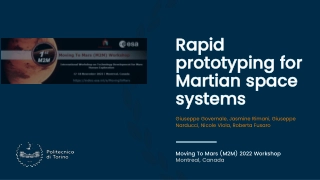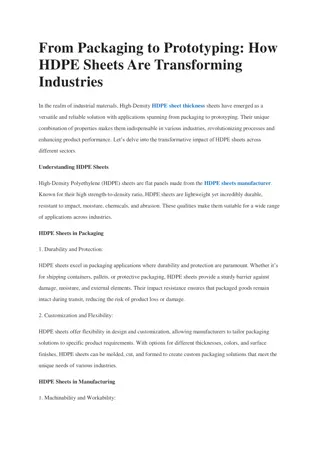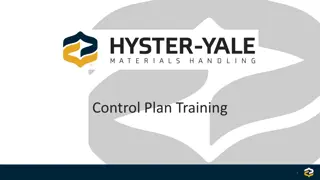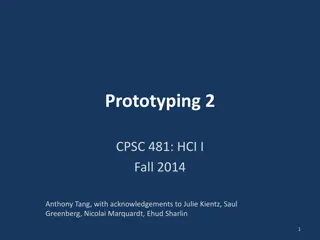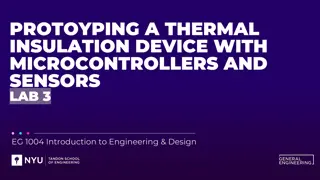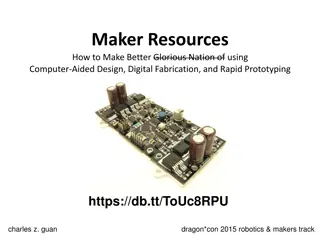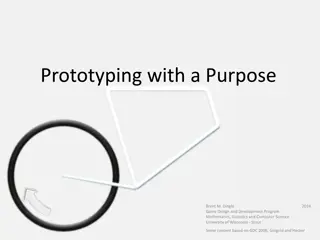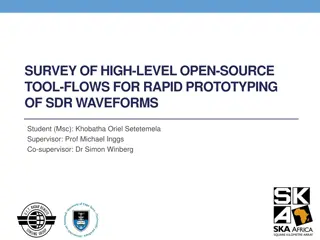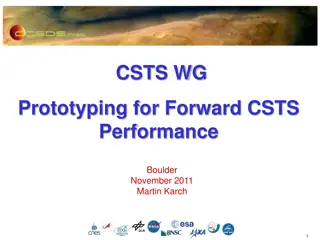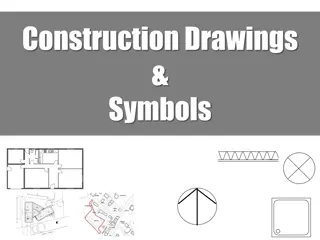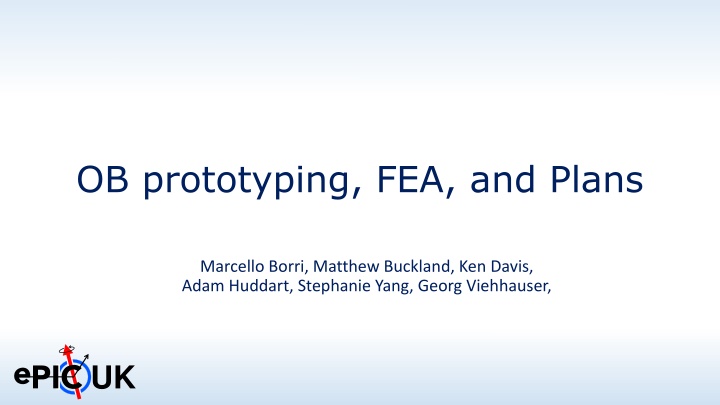
Prototype Scheme for L4 Stave: OB Prototyping, FEA, and Plans
Dive into the UK prototype scheme focusing on L4 Stave with curved facesheets, highlighting mechanical challenges, decision-making processes, and the journey towards testing structural, thermal, and flow properties.
Download Presentation

Please find below an Image/Link to download the presentation.
The content on the website is provided AS IS for your information and personal use only. It may not be sold, licensed, or shared on other websites without obtaining consent from the author. If you encounter any issues during the download, it is possible that the publisher has removed the file from their server.
You are allowed to download the files provided on this website for personal or commercial use, subject to the condition that they are used lawfully. All files are the property of their respective owners.
The content on the website is provided AS IS for your information and personal use only. It may not be sold, licensed, or shared on other websites without obtaining consent from the author.
E N D
Presentation Transcript
OB prototyping, FEA, and Plans Marcello Borri, Matthew Buckland, Ken Davis, Adam Huddart, Stephanie Yang, Georg Viehhauser, UK
Introduction UK Prototype scheme focused on L4 Stave with curved facesheets L4 staves will be most mechanically challenging (larger span, larger air flow) Decision curved vs flat will depend on bonding (flat AncASIC to curved bridge FPC) and layout optimization Impact on mechanical performance marginal (~10% from FEA) Start with minimum required tooling to assembly a quarter length stave For two 5-RSU modules mounted on opposite faces Demonstrate operation of tooling In particular compaction of carbon-fibre Can we remove internal mould parts? Two quarterstaves have been made First very successful only issue that end pieces have been crushed Due to misunderstanding for the second prototype only one layer of CF prepreg was used (90 layer missing) facesheet has longitudinal gap But we still could remove the tooling and the quarterstave is surprisingly stiff Plan to test structural, thermal performance and flow properties Will now start manufacture remaining tooling required for full length L4 stave Then move on to full length testing 2
Stave Structure UK Length Stave End 3
Prototype Components UK Stave Components Hand-cut carbon fibre top/bottom skins (2 layers (90/0) of K13C2U/EX1515) Pure Kapton FPC mock-ups SLA 3D printed Stave End Supports Production intent I-beam and K9 foam blocks 4
Prototype Components UK Tooling Co-curing tooling (for length stave) Carbon fibre I beam Tooling Kapton C-channel Tooling Internal formers Sensor curve former LAS curved carriers Module assembly tooling Module installation tooling (for full length L4) 5
Stave Tooling Photos UK Kapton Former Carbon Fibre I-beam Mould Internal Formers 6
UK Take Aways from First Quarter Stave No noticeable twist in stave Internal tooling is awkward to remove Epoxy can wick between the tooling sections Strategically placed threaded holes would allow for controlled removal of tooling End supports deformed/failed Need reinforcement Dimple in carbon skin over gap in K9 foam block If this is an issue it may be improved when using an intensifier 7
Quantitative Results UK Mass estimate Component Carbon Fibre Skin Upper Carbon Fibre Skin Lower Kapton C Channel Stave End Mounts I Beam (Half) K9 Foam Block Volume mm^3 657.837628 690.516991 206.136635 1462.491448 322.104359 1295.980514 Density kg/m^3 QTY Mass 1 1.039383 g 1 1.091017 g 2 0.585428 g 2 3.539229 g 2 1.01785 g 6 1.555177 g 8.828084 g 1580 1580 1420 1210 1580 200 Measured: 8.95 g Total Mass 3pt bend test 70 60 y = 0.2614x + 0.106 50 displacement [ m] 40 30 20 10 0 8 0 50 100 150 200 250 300 Load [g]
Stave Finite Element Analysis UK 70 60 y = 0.2614x + 0.106 50 displacement [ m] 40 30 20 0.981N 10 Vertical load applied at central K9 foam block 0 0 50 100 150 200 250 300 Load [g] 9
UK Length Stave Cantilevered Vibration Test High Stiffness End Support A modal frequency test gives more useful data A fully support length stave s resonant frequencies are difficult to measure with vibration rig (resonant frequencies around 850 Hz) A cantilevered (diving board) stave gives similar magnitude frequencies to a fully supported L4 stave ANSYS Modal model for stave without sensors gives a 1st mode frequency of 97 Hz.
V2 Length Stave Attempt 2 UK Development Focus Improve surface finish of sensor mounting surfaces Improve Carbon fibre I beam integrity and surface finish by adjusting layup Use a 2mm thick silicone intensifier sheet on face sheets Test platform for validation of thermal/pressure ANSYS models Validation models for: Thermal performance Deformation due to internal pressure Experimentally investigate: Vibration due to internal flow Carbon Fibre I beam additional layer added to top and bottom of I to improve layup Single ply 2-ply (0/90) 11
V2 Length Stave Attempt 1 UK Scrapped due to incorrect layup of carbon fibre face sheet (single layer of K13C2U) Used Silicone Intensifier Surface finish improved CNC Drag knife cut face sheets Proof of production technology Revised/Stronger End Supports Survived autoclave 12
UK Internal Pressure loss and Stave Deformation Same length stave will be used for flow testing End support has mounts for 1 mm probe compression fitting 2 Thermocouples can be positioned in the stave flow volume Use Kapton on silicon sensor mock-ups with encapsulated traces to simulate heat load of RSU, LEC Air Inlet 13
Module tooling UK We have made a first set of tooling for curved modules We have one wafer worth of dummy silicon modules (40 m, 8+2(chopped) each 5- and 6-RSU LAS dimensions) Need to remove from the backing foil For this we need a 300 mm vacuum chuck Ordered from Kyocera, but delivery only in summer 25 Plan B: send to CERN and remove backing foil there, then send back to UK in gel-pak boxes (available) In parallel: work on tooling for flat design has started 14
Module tooling for curved stave UK Vacuum Chuck on Module Installation Tooling Module Assembly Tool LAS Vacuum Chuck 15
Next steps UK Quarter Stave Tests Build more quarterstaves (robust end pieces, compactor, etc.) Test V2 quarter length stave on vibration table and compare with FEA From FEA 97 Hz for single end supported (diving board) Still waiting for vacuum chuck for extraction of mechanical dummy sensors Close one quarter stave with Kapton to start flow tests Add dummy ancASIC study temperature with air flow Prototype an FPC with representative quantity of aluminum and use in co-cure This is to demonstrate that different CTE of Al layer does not affect the co-cure Measure stave deformation with heat generation & internal pressure In parallel Wire bonding trials with curved sensor & flat ASIC Update drawings for remaining mould parts for full stave & manufacture This will include features to facilitate removal of mould parts after cure Cure a full size L4 stave 17
Additional Slides UK 18
Pictures UK 19

